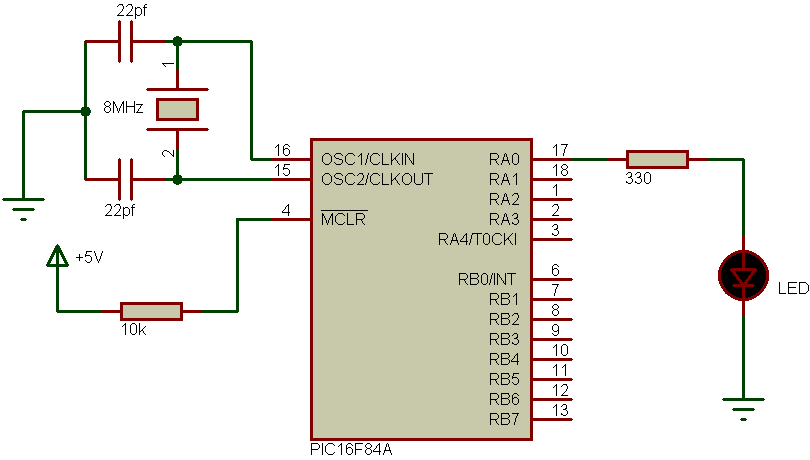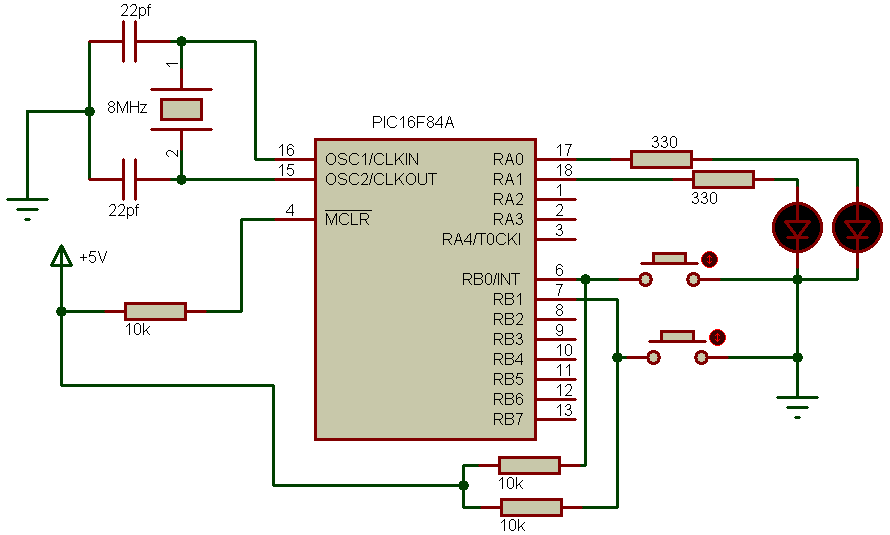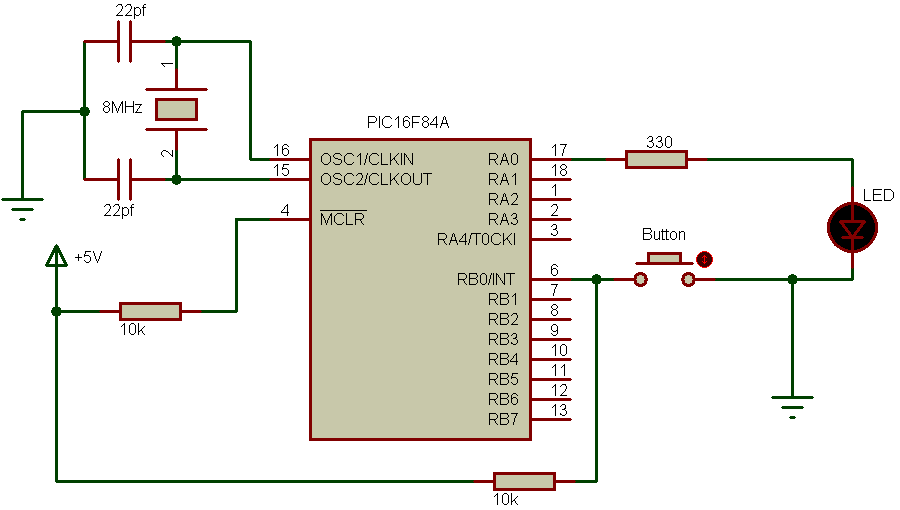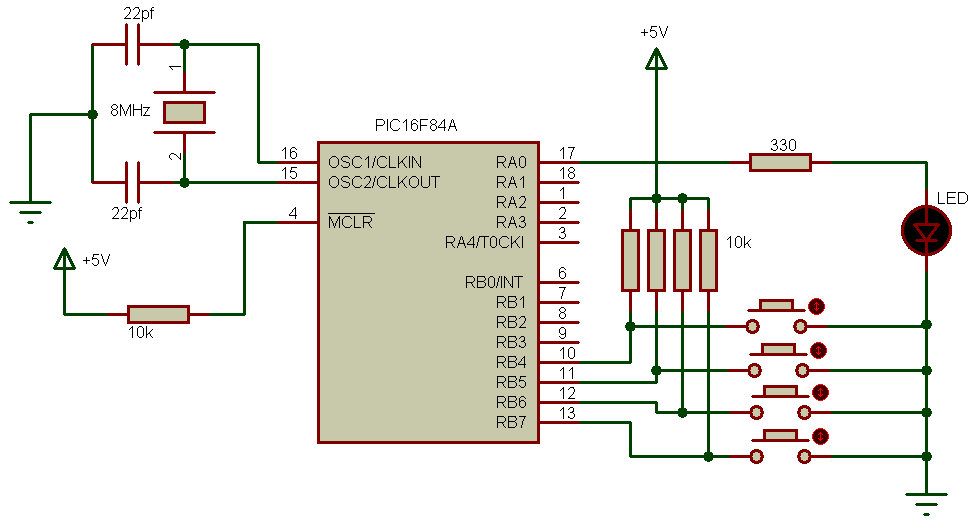A serial-in parallel-out shift register (74HC164, 74HC595, CD4094…..) can be added to a 7-segment display. The adding of the shift register minimizes the number of pins used by the 7-segment display. This topic shows how to make a 4-digit digital counter with multiplexing and 74HC164 shift register using PIC16F84A and CCS PIC C compiler.
Interfacing PIC16F84A with multiplexed 7-Segment display and shift register circuit:
Example circuit schematic is shown below where a common anode 7-segment display and 74HC164N shift register are used.
Other shift registers such as 74HC595 and CD4094 can be used in this project.
The button connected to RB2 used to increment the displayed number.
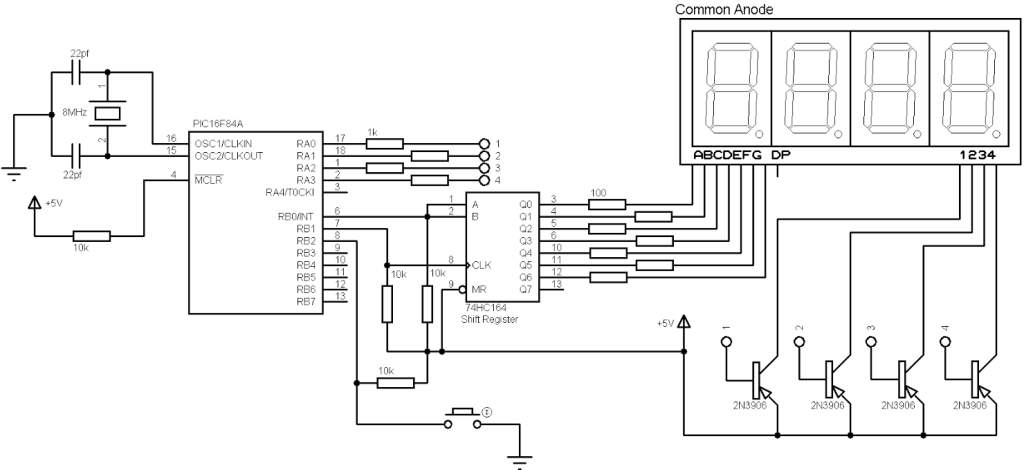
The PIC16F84A must be supplied with 5V between pins VDD (#14) and VSS (#5).
Hardware Required:
- PIC16F84A microcontroller —> datasheet
- Common anode 4-digit seven-segment display
- 74HC164 shift register —> datasheet
- 4 x 2N3906 PNP transistor —> datasheet
- Push button
- 4 x 10k ohm resistor
- 4 x 1k ohm resistor
- 7 x 100 ohm resistor
- 8 MHz crystal oscillator
- 2 x 22 pF ceramic capacitor
- 5V Power source
- Bread board and some jumper wires
- PIC microcontroller programmer (PICkit 2, PICkit 3…)
Interfacing PIC16F84A with multiplexed 7-Segment display and shift register CCS C code:
1 2 3 4 5 6 7 8 9 10 11 12 13 14 15 16 17 18 19 20 21 22 23 24 25 26 27 28 29 30 31 32 33 34 35 36 37 38 39 40 41 42 43 44 45 46 47 48 49 50 51 52 53 54 55 56 57 58 59 60 61 62 63 64 65 66 67 68 69 70 71 72 73 74 75 76 77 78 79 80 81 82 83 84 85 86 87 88 89 90 91 92 93 94 95 | // 4-Digit digital counter using PIC16F84A // Common cathode 7-segment display with shift register #include <16F84A.h> #fuses HS,NOWDT,PUT,NOPROTECT #use delay(crystal=8000000) short s; // Used to know button position unsigned int j, digit, digit1, digit10, digit100,digit1000; unsigned long i; unsigned int seg(unsigned int num) { switch (num) { case 0 : return 0xC0; case 1 : return 0xF9; case 2 : return 0xA4; case 3 : return 0xB0; case 4 : return 0x99; case 5 : return 0x92; case 6 : return 0x82; case 7 : return 0xF8; case 8 : return 0x80; case 9 : return 0x90; } } void main() { while(TRUE) { if(input(PIN_B2) == 1) s = 1; if(s == 1) { if(input(PIN_B2) == 0) { s = 0; i++; if(i > 9999) i = 0; } } digit = i % 10; digit1 = seg(digit); output_a(0x0F); // Turn off all displays for(j = 0x40; j > 0; j = j >> 1) { if(digit1 & j) output_high(PIN_B0); else output_low(PIN_B0); delay_us(10); output_high(PIN_B1); delay_us(10); output_low(PIN_B1);} output_a(0x07); // Turn on display for ones delay_ms(1); digit = (i / 10) % 10; digit10 = seg(digit); output_a(0x0F); // Turn off all displays for(j = 0x40; j > 0; j = j >> 1) { if((digit10 & j) != 0) output_high(PIN_B0); else output_low(PIN_B0); delay_us(10); output_high(PIN_B1); delay_us(10); output_low(PIN_B1);} output_a(0x0B); // Turn on display for tens delay_ms(1); digit = (i / 100) % 10; digit100 = seg(digit); output_a(0x0F); // Turn off all displays for(j = 0x40; j > 0; j = j >> 1) { if((digit100 & j) != 0) output_high(PIN_B0); else output_low(PIN_B0); delay_us(10); output_high(PIN_B1); delay_us(10); output_low(PIN_B1);} output_a(0x0D); // Turn on display for hundreds delay_ms(1); digit = (i / 1000) % 10; digit1000 = seg(digit); output_a(0x0F); // Turn off all displays for(j = 0x40; j > 0; j = j >> 1) { if((digit1000 & j) != 0) output_high(PIN_B0); else output_low(PIN_B0); delay_us(10); output_high(PIN_B1); delay_us(10); output_low(PIN_B1);} output_a(0x0E); // Turn on display for thousands delay_ms(1); } } |
Digital counter using PIC16F84A microcontroller and CCS C compiler video:
The following video shows this project in hardware circuit.
Discover more from Simple Circuit
Subscribe to get the latest posts sent to your email.
